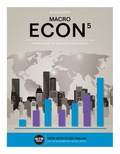
Sub-part
A
The impact of decrease in the government purchase on
Concept Introduction:
Fiscal Policy: Fiscal policy is the policy by which government regulates the nation’s economy by adjusting the government spending and controlling the tax rates. It tries to influence the
Sub-part
A
Explanation of Solution
Fiscal Policy: Fiscal policy is the policy by which government regulates the nation’s economy by adjusting the government spending and controlling the tax rates. It tries to influence the demand side of the economy.
A decrease in government purchases Decreases in government purchases will reduce the aggregate demand of the economy, thus controlling the inflation rate, but will have the reverse effect on GDP.
Sub-part
B
The impact of an increase in the net taxes on GDP.
Concept Introduction:
Fiscal Policy: Fiscal policy is the policy by which government regulates the nation’s economy by adjusting the government spending and controlling the tax rates. It tries to influence the demand side of the economy.
Sub-part
B
Explanation of Solution
Fiscal Policy: Fiscal policy is the policy by which government regulates the nation’s economy by adjusting the government spending and controlling the tax rates. It tries to influence the demand side of the economy.
An increase in net taxes Increases in net taxes will reduce the disposable income of the people. This will reduce the aggregate demand as such reduce consumer spending, and thus have a negative impact on GDP.
Sub-part
C
The impact of reduction in transfer payments on GDP.
Concept Introduction:
Fiscal Policy: Fiscal policy is the policy by which government regulates the nation’s economy by adjusting the government spending and controlling the tax rates. It tries to influence the demand side of the economy.
Sub-part
C
Explanation of Solution
Fiscal Policy: Fiscal policy is the policy by which government regulates the nation’s economy by adjusting the government spending and controlling the tax rates. It tries to influence the demand side of the economy.
A reduction in transfer payments Reduction in transfer payment will reduce consumer spending and thus will have a negative impact on GDP.
Sub-part
D
The impact of decrease in the marginal propensity to consume on GDP.
Concept Introduction:
Fiscal Policy: Fiscal policy is the policy by which government regulates the nation’s economy by adjusting the government spending and controlling the tax rates. It tries to influence the demand side of the economy.
Sub-part
D
Explanation of Solution
Fiscal Policy: Fiscal policy is the policy by which government regulates the nation’s economy by adjusting the government spending and controlling the tax rates. It tries to influence the demand side of the economy.
A decrease in the marginal propensity to consumer A decrease in marginal propensity to consume implies an increase in the rate of savings and decrease in the rate of consumer spending. This implies the rate of consumption will reduce. This will decrease GDP.
Want to see more full solutions like this?
- 5. Discrimination in the labor market The following table exhibits the name, gender, height, and minimum wage 10 people are willing to accept to work as human resource specialists at a large financial firm. Name Gender Height Minimum Wage (Inches) (Dollars per week) Paolo M 67 $298 Ginny F 63 $311 Lucia F 66 $332 Eric M 71 $354 Kenji M 69 $375 Sharon F 66 $397 Paolo M 70 $411 Carlos M 70 $440 Van M 64 $452 Amy F 69 $474 The lowest weekly wage that the financial firm can spend in order to hire five human resource specialists is____. Suppose the hiring director of the financial firm prefers taller candidates because they think it will increase revenue, and so they impose a requirement that all newly hired human resource specialists must have a height of at least 67 inches. With this mandate in place, the weekly wage rate the financial firm now must pay in order to hire five human resource specialists increases by_____.arrow_forwardnot use ai pleasearrow_forwardnot use ai pleasearrow_forward
- Problem 3 Stata Output Analysis Suppose a study investigates the causal effect of education on wages. Table 1 reports the results of an OLS regression of wages (wage per hour in dollars) on education (years in education). Table 1 Source SS df MS Number of obs = 3,017 F(1, 3015) = 298.39 Model Residual 18904467 191011981 1 18904467 3,015 63353.8909 Prob > F 0.0000 R-squared 0.0901 Adj R-squared 0.0898 Total 209916448 3,016 69600.9444 Root MSE 251.7 wage Coef. Std. Err. t P>|t| [95% Conf. Interval] education cons 29.56644 183.9342 1.711605 23.15976 17.27 0.000 7.94 0.000 26.21041 138.5237 32.92247 229.3447 a. How would you write this relationship using the Core Model? (5 points) b. What is the value for B₁, the coefficient on Education? (2 points) C. What is the standard error of ẞ₁? (2 points) d. What is the R squared for the model? (2 points) e. What is the t statistic for ₁at the 5% level of significance? (2 points) Λ f. What is the 95% confidence interval for B₁? (2 points) Λ g.…arrow_forwardProblem 2 Hypothesis Testing Suppose you are interested in the effect of neighborhood crime incidents on high school graduation rates. You run the following regression model: Graduation; ßo+ß₁Crime; +ɛ¿ = You would like to test whether the neighborhood crime incidents have a statistically significant effect on high school graduation rate at the 5% level of significance (α = 0.05). You estimate the model and find that B₁ = -0.04 and se (B₁) = 0.008. a. Write down the null hypothesis and alternative hypothesis. (4 points) b. Calculate thet statistic of B₁. (5 points) C. What is the critical value of thet statistic for the 5% level of significance? (2 points) d. Calculate the 95% confidence interval for the coefficient on Crime? (6 points) e. Based on your answers to the questions b, c, and d, do you reject or fail to reject the null hypothesis you defined in question a? Justify your answer. (5 points) Λ f. Isẞ₁ statistically significant at the 5% level? (3 points)arrow_forwardProblem 1 Endogeneity & Bias The ACT (an abbreviation of American College Testing) is a standardized test used for college admissions in the United States. Suppose you are interested in whether ACT preparation improves ACT scores. Consider the following model: ACT=B+B Preparation,+e; where Preparation measures the number of hours spent on ACT preparation and ACT is ACT scores. Each student is denoted by the subscript i. Suppose you estimate = - 21 andß₁ = 0.9. a. What is the dependent variable? What is the independent variable? (3 points) b. How do you interpret ẞ = 21 in this context? (4 points) 0 C. How do you interpretß₁ = 0.9 in this context? (4 points) 1 d. Describe a scenario which can cause the independent variable to be endogenous. (4 points)arrow_forward
- How does mining raw materials fir tech companies like apple affect the humar right violation all over the worldarrow_forwardConsider the market for electricity. Suppose that a power plant dumps byproducts into a nearby river, creating a negative externality for those living downstream from the plant. Producing additional electricity imposes a constant per-unit external cost of $490. The following graph shows the demand (private value) curve and the supply (private cost) curve for electricity. Use the purple points (diamond symbol) to plot the social cost curve when the external cost is $490 per unit. PRICE (Dollars per unit of electricity) 1400 1260 1120 980 840 700 560 420 280 140 ° D 1 2 3 D Supply (Private Cost) Demand (Private Value) 5 6 7 QUANTITY (Units of electricity) Social Cost The market equilibrium quantity is units of electricity, but the socially optimal quantity of electricity production is units. To create an incentive for the firm to produce the socially optimal quantity of electricity, the government could impose a unit of electricity. perarrow_forwardHow do mining of raw materials for a tech industry affects the human rights in the worldarrow_forward




 Survey of Economics (MindTap Course List)EconomicsISBN:9781305260948Author:Irvin B. TuckerPublisher:Cengage Learning
Survey of Economics (MindTap Course List)EconomicsISBN:9781305260948Author:Irvin B. TuckerPublisher:Cengage Learning Economics (MindTap Course List)EconomicsISBN:9781337617383Author:Roger A. ArnoldPublisher:Cengage Learning
Economics (MindTap Course List)EconomicsISBN:9781337617383Author:Roger A. ArnoldPublisher:Cengage Learning





